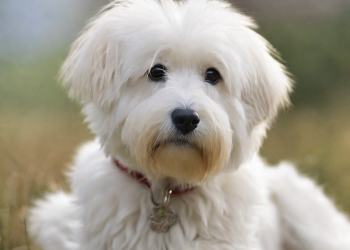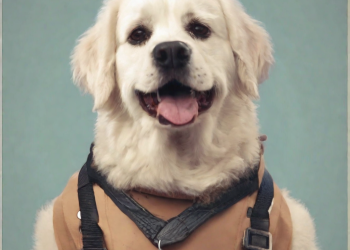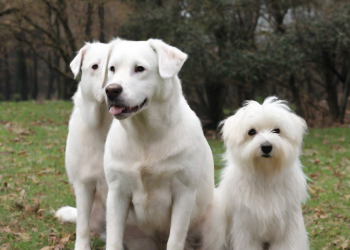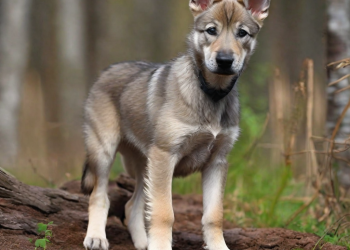The Iberian wolfdog: a unique species in Spain
During my research on the Iberian wolfdog, I discovered that this breed of dog is an important part of Spain’s culture and biodiversity. Over the centuries, it has evolved and adapted to its natural environment, but its existence is threatened by habitat loss and illegal hunting. However, thanks to the protection and conservation measures implemented, there is still hope for the future of this fascinating species.
What is an Iberian wolfdog?
An Iberian wolfdog is a breed of dog native to the Iberian Peninsula, characterized by its wolf-like appearance and strong pack instinct. They are intelligent, loyal and very active animals, traditionally used for hunting and protecting livestock.
If you want to learn more about this fascinating dog breed and discover why it is so popular in the Iberian Peninsula, continue reading our article. You will be surprised with everything you will learn about the Iberian wolfdog!
II. Origin and evolution of the Iberian wolfdog
The Iberian wolfdog is a dog breed native to the Iberian Peninsula, specifically the Cantabria region in Spain. Their origin dates back thousands of years, when wolves began to be domesticated by humans to help with hunting and protection.
Throughout history, the Iberian wolfdog has evolved and adapted to its environment and the needs of its owners. However, it still maintains many of the characteristics of its wolf ancestors, making it a unique and fascinating breed.
Some of the most notable differences between the Iberian Wolfdog and other dog breeds are:
- Its size and weight: the Iberian wolfdog is a large and robust breed, with an average weight of 30 to 40 kilograms.
- Its coat and color: Its coat is dense and rough, with a soft undercoat that protects it from the cold. Its color can vary from gray to brown, with white spots on the chest and legs.
- Its body structure: the Iberian wolfdog has a muscular and well-proportioned body, with strong legs and a long, hairy tail.
These physical characteristics are the result of its evolution and adaptation to the climate and terrain of the Iberian Peninsula, making it a resistant dog capable of surviving in difficult conditions.
III. Physical characteristics of the Iberian wolfdog
The Iberian wolfdog is a breed of dog native to the Iberian Peninsula, specifically Spain and Portugal. Over the centuries, it has evolved to adapt to its environment and develop unique physical characteristics that set it apart from other dog breeds.
A. Size and weight
The Iberian wolfdog is a large breed, with an average height of 70 cm and a weight that ranges between 30 and 40 kg. However, there are variations in size and weight depending on the region of origin and the lineage of the dog.
B. Coat and color
The coat of the Iberian wolfdog is one of its most distinctive characteristics. It is dense, rough and waterproof, allowing it to survive in its natural habitat. Its color varies between shades of gray, brown and black, with white markings on the chest and legs.
C. Body structure
The Iberian wolfdog has a strong and muscular body structure, with long legs and a long, hairy tail. Its head is large and triangular, with erect ears and almond-shaped amber eyes. Its body is designed for hunting and survival in the wild.
D. Comparison with other dog breeds
Although the Iberian wolfdog shares some physical characteristics with other dog breeds, such as the Siberian husky and wolf, it has significant differences. For example, their fur is thicker and more resistant than that of a husky, and their size is larger than that of a wolf.
- The Iberian wolfdog has a thicker and more resistant coat than the Siberian husky.
- Its size is larger than that of a wolf.
- Their body structure is designed for hunting and survival in the wild.
IV. Behavior and temperament of the Iberian wolfdog
The Iberian wolfdog is a breed of dog with a unique behavior and temperament, inherited from its wolf ancestors. Below are some of its most notable features:
Hunting and protection instincts
Being descendants of wolves, Iberian wolfdogs have a strong hunting and protection instinct. This means that they are excellent hunters and can be very territorial and protective of their family and their territory. It is important to take this instinct into account when training and socializing an Iberian wolfdog, as it can be difficult to control if not handled properly.
Activity level and exercise needed
The Iberian Wolfdog is a very active breed and needs a lot of exercise to stay healthy and happy. They are dogs that enjoy running and exploring, so they need a large, safe space to do so. Additionally, it is important to provide them with mentally stimulating activities, such as sniffing games or obedience training, to keep their minds occupied.
Relationship with other dogs and animals
Due to their strong hunting instinct, Iberian wolfdogs may have difficulty interacting with other dogs and animals. It is important to socialize them from an early age and supervise their interactions with other animals to avoid possible conflicts. It is also advisable to keep them in a safe, fenced space to prevent them from chasing other animals.
Relationship with humans
Despite their imposing appearance and protective instinct, Iberian wolfdogs can be very affectionate and loyal to their owners. However, it is important to establish a relationship of respect and trust with them from the beginning, as they can be distrustful of strangers. It is also important to note that they are independent dogs and will not always seek human attention like other dog breeds.
Training and socialization
Training and socialization are essential for the Iberian wolfdog. Because of their strong hunting and protection instincts, it is important to set clear boundaries and teach them to control their energy and behavior. It is also essential to socialize them from an early age so that they learn to interact properly with other dogs and people.
In summary, the Iberian wolfdog is a breed with a unique behavior and temperament, which requires adequate education and socialization to be a good companion. With proper care and training, these dogs can make excellent pets and life companions.
V. Habitat and distribution of the Iberian wolfdog in Spain
The Iberian wolfdog is a species endemic to the Iberian Peninsula, so its natural habitat is mainly in Spain. However, small populations can also be found in Portugal and in some areas of France. The main characteristics of the habitat and distribution of the Iberian wolfdog in Spain are detailed below.
A. Geographic areas where the Iberian wolfdog is found
The Iberian wolfdog is found mainly in the northern half of Spain, in areas such as the Cantabrian Mountains, the Pyrenees, the Sierra de Gredos and the Sierra Morena. Some populations can also be found in the central and southern area of the country, such as in the Sierra de Guadarrama and the Sierra Nevada.
In general, the Iberian wolfdog prefers mountainous and wooded habitats, with dense vegetation that allows it to camouflage and hunt more easily. However, sightings have also been recorded in more open areas, such as in the Spanish pasture.
B. Characteristics of the natural habitat of the Iberian wolfdog
The natural habitat of the Iberian wolfdog is very varied, as it adapts to different types of terrain and climate. However, in general, it prefers areas with a lot of vegetation, such as forests and mountains, where it can find prey to hunt and shelters to rest.
In addition, the Iberian wolfdog is a very territorial species, so it needs ample space to move and hunt. It is estimated that a pack of Iberian wolfdogs can occupy a territory of up to 200 km².
C. Threats and habitat conservation of the Iberian wolfdog
Despite being a protected species in Spain, the habitat of the Iberian wolfdog is threatened by various human activities, such as forest clearing, road construction, and the expansion of agriculture and livestock. This reduces the space available for the species and makes its survival difficult.
For this reason, conservation measures have been implemented to protect the habitat of the Iberian wolfdog, such as the creation of nature reserves and the promotion of sustainable practices in the areas where the species lives. However, there is still much to do to ensure the survival of this emblematic species in its natural habitat.
SAW. Feeding of the Iberian wolfdog
The Iberian wolfdog is a carnivorous species that feeds mainly on wild prey in its natural habitat. However, in captivity their diet must be carefully controlled to ensure that they receive all the nutrients necessary for their health and well-being.
Natural diet of the Iberian wolfdog
In its natural habitat, the Iberian wolfdog feeds mainly on small mammals such as rabbits, hares and rodents, as well as birds and reptiles. They can also hunt larger prey such as deer and wild boar in packs.
In addition to meat, the Iberian wolfdog also consumes fruits and vegetables in small quantities, which provides them with essential vitamins and minerals for their diet.
Feeding in captivity
In captivity, the Iberian wolfdog’s diet must be carefully controlled to ensure that it receives a balanced diet appropriate to its nutritional needs. A diet based on high-quality raw meat, such as chicken, beef or lamb, supplemented with fresh fruits and vegetables is recommended.
It is important to avoid processed foods or foods high in carbohydrates, as they can cause health problems in this species. Care must also be taken with the amount of food given, since the Iberian wolfdog is prone to obesity if overfed.
Specific nutritional needs
The Iberian wolfdog has specific nutritional needs due to its carnivorous nature and its size and weight. They need a diet rich in protein and fat, as well as calcium and phosphorus to keep their bone structure strong and healthy.
Additionally, it is important to ensure that they receive enough vitamin D, as their thick, dark coat can make it difficult to absorb this essential vitamin for bone health.
Health problems related to diet
An inadequate diet can cause health problems in the Iberian wolfdog, such as obesity, digestive problems, and nutritional deficiencies. Therefore, it is important to consult with a veterinarian or an animal nutrition expert to ensure that their diet is adequate and balanced.
It is also important to keep in mind that the Iberian wolfdog is a protected species and should not be hunted for consumption. Any food given must be of safe and legal origin.
VII. Reproduction and breeding of the Iberian wolfdog
The Iberian wolfdog is a species that reproduces in a similar way to other wolves and wild dogs. The most important aspects of its reproductive and breeding cycle are detailed below.
A. Reproductive cycle of the Iberian wolfdog
Like other wolves, the Iberian wolfdog has an annual reproductive cycle that begins in January and ends in May. During this time, females come into heat and may mate with several males. Gestation lasts approximately 63 days and litters usually have between 4 and 6 puppies.
B. Care during pregnancy and childbirth
During pregnancy, females usually look for a safe and protected place to give birth, such as a cave or natural shelter. Males do not usually participate in caring for the cubs, so it is the female’s responsibility to feed and protect them.
C. Puppy development
Iberian wolfdog puppies are born blind and deaf, and are completely dependent on their mother during the first weeks of life. As they grow, they begin to explore their surroundings and learn hunting and survival skills from their mother. At 6 months, the cubs are already able to hunt on their own and become independent from their mother.
D. Common health problems in breeding the Iberian wolfdog
Like other dog breeds, the Iberian wolfdog can suffer from health problems such as hip dysplasia, eye diseases, and skin problems. It is important for responsible breeders to perform genetic testing and monitor the health of their dogs to prevent the spread of these diseases.
In summary, the reproduction and breeding of the Iberian wolfdog follows a cycle similar to that of other wolves and wild dogs. However, due to its conservation status, it is important that it be carried out in a responsible and controlled manner to guarantee the health and survival of the species.
VIII. Relationship of the Iberian wolfdog with humans
The Iberian wolfdog has had a long history of coexisting with humans in Spain. Over the centuries, it has been used for various purposes and has played an important role in the country’s culture and biodiversity.
History of the relationship between the Iberian wolfdog and humans
The Iberian wolfdog is believed to have been present in the Iberian Peninsula for more than 10,000 years, making it one of the oldest dog breeds in Europe. For centuries, it has been used by shepherds to protect livestock and by hunters to aid in hunting.
Traditional uses of the Iberian wolfdog in Spain
In addition to its role as protector and hunter, the Iberian wolfdog has also been used in transhumance, an ancient herding system in which flocks moved from one place to another in search of pasture. It has also been used in hunting larger game, such as wild boar and deer, due to its strength and agility.
Role of the Iberian wolfdog today
Today, the Iberian wolfdog is still used in some areas of Spain for the protection of livestock and as a hunting dog. However, it has also become a popular pet around the world due to its beauty and loyal and protective nature.
Benefits and challenges of having an Iberian wolfdog as a pet
While having an Iberian wolfdog as a pet can be a wonderful experience, it also comes with certain challenges. Due to their wild nature, these dogs require proper socialization and training to adapt to life in a home. Additionally, their size and need for exercise can be a challenge for some owners.
Conclusions
The relationship between the Iberian wolfdog and humans has evolved over the centuries, and today it remains an important part of Spain’s culture and biodiversity. Although its conservation and protection are essential for its survival, it is also important to take into account the challenges and responsibilities that come with having an Iberian wolfdog as a pet.
IX. Myths and realities about the Iberian wolfdog
A. Common myths about the Iberian wolfdog
There are many myths and false beliefs about the Iberian wolfdog, some of the most common are:
- It is a wild and dangerous animal.
- He is untrainable and cannot be a good companion.
- It’s a wolf disguised as a dog.
- He is aggressive and cannot live with other animals or children.
B. Denials and clarifications about these myths
These myths are false and are based on a lack of knowledge and misinformation about this breed of dog. Below are some clarifications on these myths:
- The Iberian wolfdog is not a wild animal, it is a breed of domestic dog that has been selectively bred for centuries.
- With proper training and early socialization, the Iberian Wolfdog can be an excellent companion and pet.
- Although it shares some physical characteristics with the wolf, the Iberian wolfdog is a completely different breed of dog.
- Like any other breed of dog, the Iberian Wolfdog can be aggressive if not trained and socialized properly. However, with proper training, he can be a calm and friendly dog.
C. Facts about the Iberian wolfdog that are not so well known
Despite the myths and false beliefs, there are some realities about the Iberian wolfdog that are not so well known:
- It is a very loyal and protective breed of dog, which makes it an excellent guard dog.
- It has a strong learning capacity and can be trained to perform various tasks, such as rescue and drug detection.
- He is a very active dog and needs a lot of exercise and mental stimulation to be happy and healthy.
- It is a breed in danger of extinction and its conservation is of vital importance to preserve biodiversity in Spain.
Protection and conservation of the Iberian wolfdog in Spain
The Iberian wolfdog is an emblematic species of Spain, but it is also in danger of extinction. For this reason, it is important to take measures to protect and conserve this unique and valuable species. In this section, we will explore the conservation status of the Iberian wolfdog in Spain, the threats it faces and the measures being taken to protect it.
Conservation status of the Iberian wolfdog in Spain
According to the International Union for Conservation of Nature (IUCN), the Iberian wolfdog is in danger of extinction in Spain. This is mainly due to habitat loss and illegal hunting. It is estimated that there are only around 250 specimens left in the wild on the Iberian Peninsula.
In addition, the Iberian wolfdog also faces hybridization with domestic dogs, which can affect its genetic purity and its ability to adapt to the environment.
Threats and dangers facing the species
The main threat to the Iberian wolfdog is the loss of habitat due to human expansion and agricultural and livestock activity. This reduces their territory and their ability to find food and shelter. In addition, illegal hunting and hybridization with domestic dogs are also great dangers for the species.
Another major threat is the lack of awareness and understanding about the importance of the Iberian wolfdog in the ecosystem. Many people see it as a threat to livestock and hunt it without taking into account its crucial role in the balance of nature.
Protection and conservation measures implemented
To protect and conserve the Iberian wolfdog, several measures have been implemented in Spain. One of them is the creation of protected areas, such as the Sierra de la Culebra National Park, where hunting is prohibited and the conservation of the species is promoted.
Reintroduction programs have also been carried out in areas where the species had become extinct, such as in the Sierra de la Demanda in the La Rioja region. These programs seek to increase the population of Iberian wolfdogs and improve their genetic diversity.
Other measures include education and awareness about the importance of the Iberian wolfdog in the ecosystem and the promotion of sustainable practices in livestock farming to reduce conflicts between wolfdogs and livestock.
Role of authorities and organizations in the protection of the Iberian wolfdog
Spanish authorities, such as the Ministry for the Ecological Transition and the Demographic Challenge, have a crucial role in the protection and conservation of the Iberian wolfdog. Through monitoring and management programs for the species, we seek to guarantee its survival and coexistence with local communities.
In addition, organizations such as the Association for the Conservation and Study of the Iberian Wolf (ASCEL) and the Foundation for the Conservation of the Iberian Wolf (FCL) also play an important role in the protection and conservation of the Iberian wolf dog through research, education and awareness.
In conclusion, it is essential to continue taking measures to protect and conserve the Iberian wolfdog in Spain. This species is an important part of Spanish biodiversity and culture, and its survival is crucial to maintaining the balance of ecosystems. We all have a role to play in protecting it and it is important to be aware and act accordingly.








